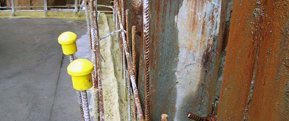
There are several types of waterstop systems available. Since the late 1950s, the conventional choice has been waterstop systems that use a physical barrier to block water penetration. Most commonly, a strip of sodium bentonite (clay) is applied to the joint site, or a PVC barrier is placed into a wall or slab before an adjoining wall was poured.
While these systems provide waterstop protection, they also present a number of challenges. Shifting or damage during concrete pours can leave joints unprotected and susceptible to leakage. They require more expensive, skilled labour to install, and they have a finite life, meaning they will eventually deteriorate.
With a crystalline waterstop system such as Kryton’s Krystol Waterstop System, a cementitious mixture containing a high concentration of crystalline chemicals is applied to the joint area before a new wall is poured. The crystalline technology creates a chemical reaction that causes millions of needle-like crystals to grow, filling the spaces between concrete particles and blocking the movement of water in all directions.

The best way to achieve an effective, watertight seal and protect your concrete structure from expensive and inconvenient leakage problems is to use a reliable waterstop system in combination with an overall waterproofing system.



